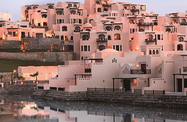The local tourism sector received a welcome boost on April 13 when Ras Al Khaimah’s ruler, Sheikh Saud bin Saqr Al Qasimi, issued a decree to establish a dedicated Tourism Development Authority. The body will be tasked with administering the planning, development and regulation of the emirate’s tourism industry. With knock-on effects for transport, property and retail, the sector is seen Gulf-wide as a driver of diversification and economic development.
With competition increasing across the region, RAK is looking to develop niche markets. Last October’s relaunch of the emirate’s flagship carrier, RAK Airways, is indicative of this approach. The airline has branded itself as a low-cost, high-value carrier, offering budget fares while retaining some of the luxuries of traditional air travel. “Our aim is to occupy a niche segment between the full-service carriers and the low-cost carriers,” RAK Airways CEO, Omar Jahameh, told OBG. “We aim to deliver a value offering that differentiates itself from low-cost carriers.”
One of the airline’s key customer demographics is the country’s South Asian expatriate workforce. The subcontinent is the company’s top destination, and expansion plans are afoot to accommodate demand. Last October, the airline decided to expand its weekly flights to Calicut in Kerala from four to five, and in late April the airline suggested it was also looking to increase flights to Jeddah to facilitate travel for Indian visitors to the Saudi city. In December last year, the company announced three new routes, two of which are Dhaka and Chittagong in Bangladesh. The third, Cairo, also represents an important expansion for the company, as Egypt is RAK’s number two destination after India in terms of passenger traffic.
Like air travel, the hotel industry in the Gulf is competitive, with other emirates and neighbouring countries vying to boost their total number of hotel nights, particularly at the four- and five-star levels. Growth in hotel guests staying in the emirate has been impressive, rising 132% from 235,000 to 542,000 between 2008 and 2009. The majority of visitors come from Europe (54%) and elsewhere in the UAE (37%), with smaller numbers coming from other Arab countries, Asia and Africa.
The bulk of hotel capacity – some 79% – is in five-star accommodation, a trend that seems set to continue. Earlier this year Hilton signed an agreement with the Al Hamra group to build the Waldorf Astoria Ras Al Khaimah, which is scheduled to open its doors in the fourth quarter of 2011. It will be the first Waldorf in the UAE and only the second in the region. Another high-profile project is the recently completed “seven-star” Palace Ras Al Khaimah, which boasts 348 suites, a 1700-sq-metre spa and an 18-hole golf course. Despite this preponderance of luxury hotels, room rates are competitive when compared to other emirates, the wider Gulf region and the eurozone. Rather like its approach to air travel, RAK seems to be carving out a high-value lower-cost niche for itself.
The emirate has also been leveraging its unique geography, which includes the Hajjar Mountains along the border with Oman and the 1000-metre-deep valley of Wadi Bih, known as the “Grand Canyon of the UAE”. Projects that take advantage of this topography include the Banyan Tree Al Wadi, a 100-ha desert resort with a 60-ha nature preserve, and Khatt Springs, a spa built around the only natural hot springs in the UAE.
The approach to air travel and hotels underscore the emirate’s broader tourism agenda, which emphasises its strengths to expand the boundaries of existing markets. With careful implementation, such plans could do much to raise the number of incoming tourists. Indeed, encouraging more visitors has been a longstanding goal for authorities, who have announced their aspiration to raise the number of annual hotel visitors to 2.5m by 2012, an ambitious goal given that its 2009 total was 542,000.
Given the scale of investments in current and scheduled tourism projects – standing at some $5bn last year – and the government’s signalled emphasis on the sector with the creation of the Tourism Development Authority, the future looks to be full of opportunities.

